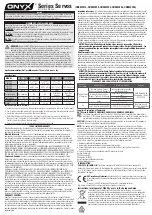
Configuration
2−130
l
EDSVF9383V−EXT EN 2.0
2.4.44.2
Deactivation of the motor potentiometer
You can deactivate the function of the motor potentiometer using the input MPOT1−INACT.
l
The motor potentiometer function is deactivated with MPOT1−INACT = HIGH.
l
The input MPOT1−INACT has priority over the inputs MPOT1−UP and MPOT1−DOWN.
l
When the function is deactivated, the output signal at MPOT1−OUT follows the function set
under C0264. You can set the following functions under C0264:
C0264
Meaning
0
No further action; the output MPOT1−OUT keeps its value
1
The motor potentiometer returns to 0 % with the corresponding Ti time
2
The motor potentiometer approaches its lower limit (C0261) with the corresponding deceleration time
3
The motor potentiometer immediately changes its output to 0%
(important for emergency stop function)
4
The motor potentiometer immediately changes its output to the lower limit (C02619
5
The motor potentiometer approaches its upper limit (C0260) with the corresponding Ti time
If the deactivation of the motor potentiometer is cancelled with MPOT1−INACT = LOW, the
subsequent function depends on
l
the momentary output signal,
l
the set limits (C0261: lower limit, C0260: upper limit),
l
the control signals MPOT1−UP and MPOT1−DOWN.
If the output value is out of the limits, the output signal approaches the next limit with the suitable T
i
time (C0262: acceleration time T
ir
, C0263: deceleration time T
if
). This function is independent of the
control inputs MPOT1−UP and MPOT1−DOWN
If the output value is within the limits, the output signal follows the selected control function
MPOT1−UP, MPOT1−DOWN or no action.
Tif
Tir
Tir
Tif
MPOT1
−
UP
MPOT1
−
DOWN
C0260
C0261
0
MPOT1
−
OUT
Tif
MPOT1
−
INACT
Fig. 2−103
Deactivation of the motor pot via the input MPOT1−INACT
















































